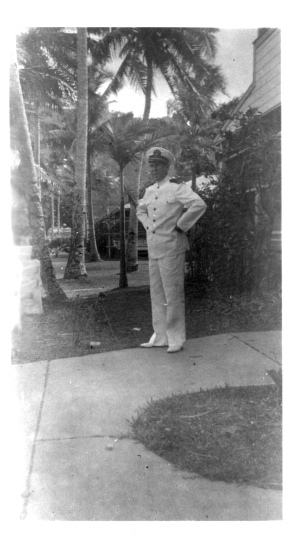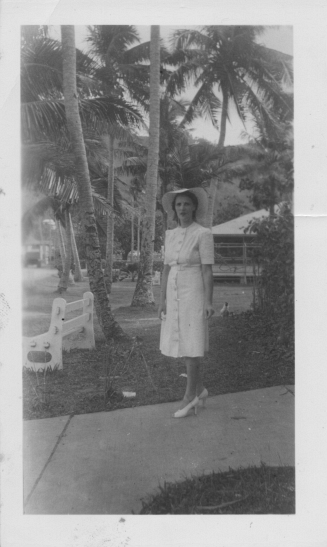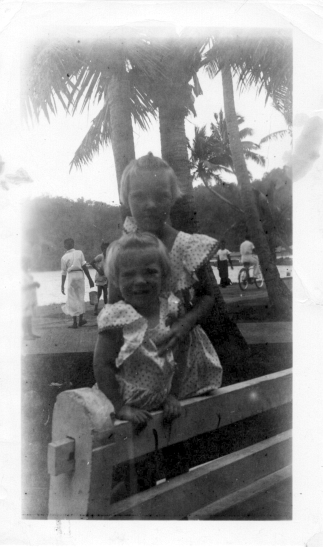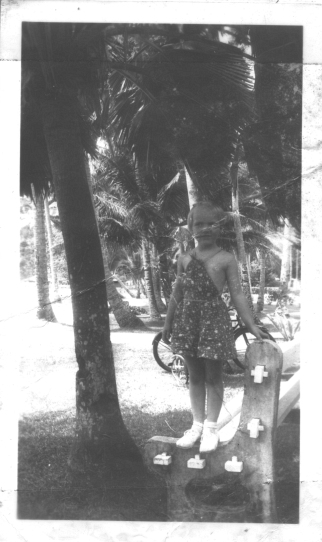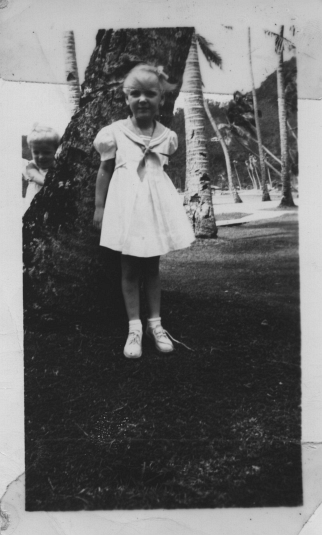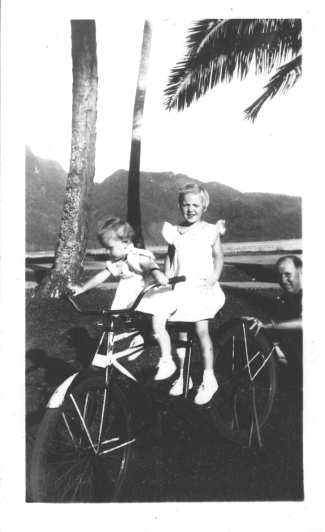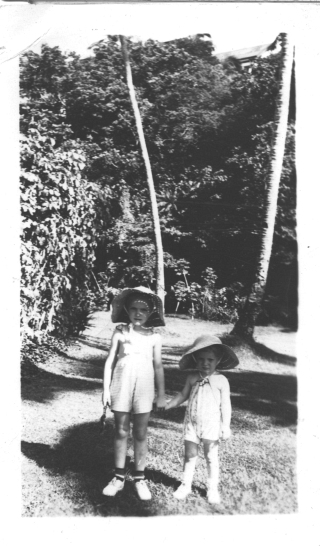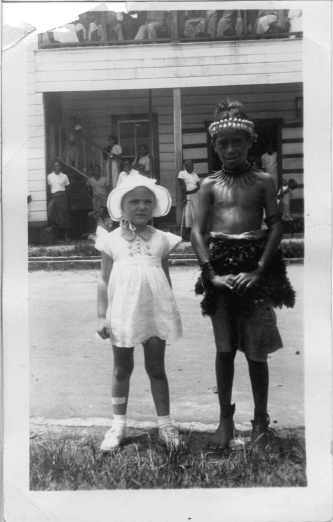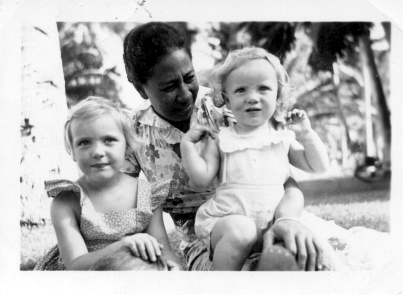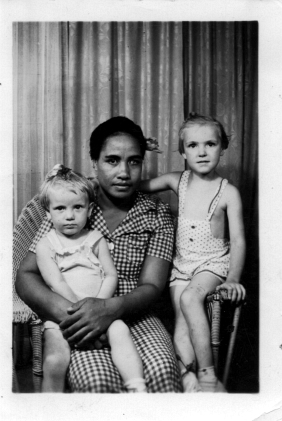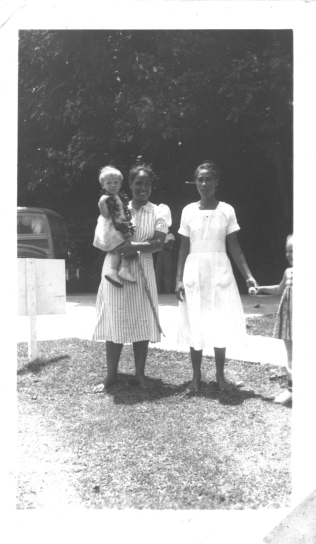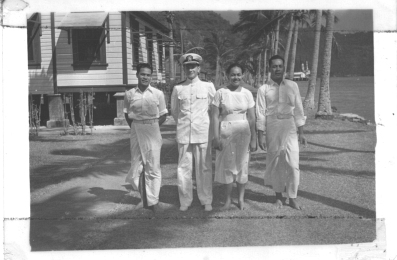|
My Family in American Samoa
before the Second World War by John Fuhring Page 7 of 7 Please click here to begin at the beginning Dr. and Mrs. Fuhring, their daughters, Samoan house staff and friend.
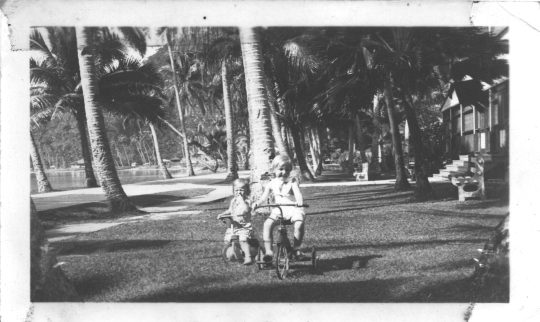 Barbara (left) and
Mary Ann
Beach to the left, housing to the right. Can you even imagine living anywhere more beautiful?
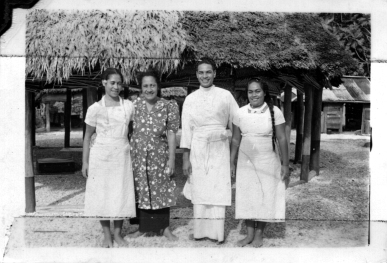 I believe these Samoans are hospital staff.
Before leaving I should briefly mention Brother Fred Henry. Brother Henry was a German priest who was sent to Western Samoa (known then as German Samoa) as a young man before World War 1 when Western Samoa was part of the Imperial German Empire. Kaiser Wilhelm was very eager that German culture and learning should be spread in the colonies so Brother Henry and many young German men were sent out. After WW I, the German Empire was entirely dismantled and Western Samoa was (mis)ruled by New Zealand and the United States kept East Samoa for itself. The natives of the Western Samoa suffered terribly under the Hitler-like tyrant the government of New Zealand sent out to (mis)rule them. The man even looked like Hitler. There is a horrific story of how this bastard allowed thousands and thousands of natives to die of the 1918 Spanish Flu because of his stubborn pride. Not a single Samoan on the American administered islands died of the flu, but this cruel man hated Americans and would not accept their advice or medical help. Well, I got off the subject. Brother Henry learned to love the Samoan people and their culture. To make a long story short, his knowledge and expertise in the Samoan language and traditions was so extensive that he became the first non-native to earn the title of Samoan Orator or Talking Chief. He was a good man who did not let his Christian faith cause him to denigrate the beliefs and culture of another people as the cursed fundamentalists have done in that part of the world since. Brother Henry was the headmaster of the school for native children and wrote both a history of Samoa and a complete dictionary of the Samoan language. Dr. Fuhring had a great respect for the Religious Orders and made friends with Brother Henry soon after arriving. Because dad was a specialist in throat diseases, Brother Henry came to dad with a problem he was having. It was my father's sad duty to inform Brother Henry that he had an inoperable case of throat cancer that he would die of. It was at this time that Brother Henry typed out and gave my dad a manuscript detailing the history and legends of the Samoan People. He asked Dr. Fuhring to publish it someday, but not right until after his death because two of the Chiefs (Tufile & Leiato) did not want the common people to know some of the some of the stories. Not long after this, World War 2 began, my dad was sent away and he lost all contact with Brother Henry. I have since learned that Brother Henry survived for two more years and during that time he wrote a second history of the Samoan People and his dictionary of the Samoan language. At the end of this page I have a link to another page that has more on Brother Henry. I invite you to please look that over if you are interested when you are finished with this story. My parents always spoke of their brief time on Samoa as the happiest time of their lives. They were completely unaware of what was going on in the rest of the world and how forces were at work that would soon end this happy situation. A month or so after Pearl Harbor was attacked, a Japanese submarine surfaced and shelled the Naval Station with its deck gun. A large fragment of shell went through the chair my dad normally sat in when he was in his office. This shelling scared the bejezus out of everyone including the commanding officer of the Island. Everyone panicked and the women and children were rounded up and quickly sent to an old school house on the far side of the island. Living conditions there were worse than dreadful and people started to get sick almost immediately. Mary Ann remembers that everybody slept on the bare floors of the schoolrooms and that they had to bathe in the ocean and how the Ivory Soap would drift off in the tide and be lost. My mother remembered with some bitterness the stupidity of sending the women and children off like that to live in abject squalor. Finally the authorities woke up to the fact that the women and children were suffering great hardships and that the entire military operation was at risk by having them unprotected out there. All a Japanese submarine captain would have to do would be to land a party of a dozen sailors and capture the women and children. They could then be held hostage and force the military authorities into an unthinkable decision. After good sense had returned and everybody was back in their houses, arrangements were made to quickly evacuate the women and children to the United States. One of the sister ships to the SS Monterey, either the SS Lurline or the SS Mariposa - I can't remember which, was hastily brought out to Samoa and picked up my mother and sisters along with the other evacuees. The voyage back to San Francisco was extremely harrowing as many real or imagined sightings of submarines occurred several times each day and each night. Every time someone saw or thought they saw a sub, the ship would sound the alarm and then begin a violent zig-zag to avoid torpedoes. My mother was made deathly sea-sick and was so frightened the whole time she and the girls were at sea, she wanted nothing to do with ships or boats the rest of her life. The fact is that these Matson Line ships were some of the fastest ships on the ocean and their speed greatly protected them from submarines. After this harrowing voyage, mom and the sisters landed at San Francisco to the cold and fog that this city is so justly famous for. In the words of Samuel Clemens,"the coldest winter I ever spent was a summer in San Francisco" and anybody that has ever been there knows the truth in that little joke. All mom and the girls had to wear was the tropical clothes they had with them. They were freezing with the cold, without money, without warm clothes and their nearest friends and family were thousands of miles away. The Red Cross met them soon after docking and provided them with warm coats and blankets. Back on Samoa, my father was ordered to leave and to report to the Philadelphia Ship Yard to take an assignment as a flight surgeon on "the unluckiest ship in the Navy," the USS Princeton. As the ship was still being built, but almost complete, it was nearly destroyed by a major leak of aviation gasoline right there at the dock while both my parents were on the ship attending its launch party. There was near panic as everybody had to get off the ship as quickly as possible before it caught on fire. The Princeton somehow didn't catch on fire, but made it to sea where she participated in several major actions and earned five battle stars. Later, off the coast of Luzon in the Philippines, a single 500 pound bomb dropped by a lucky Japanese plane started a huge fire and the USS Princeton sank through a series of unfortunate happenings. Through the terrible fire and resulting explosions, somehow most of the men got off the ship alive. There is much more I could say, but the tale of my family's adventure on Samoa is now complete.
All this was long ago and far away and the world has changed
many times
since. Will today's children be able to look back at a world
that
is in their eyes as beautiful and exciting as this one was before the
war ruined everything?
End Did you like the story or was it
a disappointment? I would appreciate reading your comments
Please sign my guestbook before leaving If you entered this story in the middle somewhere, Please go to the beginning For more on Brother Henry, please go to Brother Henry of Samoa I have a lot of other stories that can be found at My Website's Home Page |
